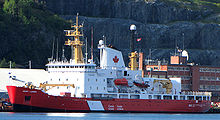Henry Larsen (explorer)

Henry Asbjørn Larsen (September 30, 1899 – October 29, 1964) was a Norwegian-
RCMP service
In 1928 the RCMP commissioned St. Roch for Arctic service. During its first voyage into the Arctic, Larsen served as mate under a captain that the RCMP hired, but, once in the Arctic, Larsen was appointed captain. Larsen commanded St. Roch for most of the next two decades, rising to the rank of sergeant. In the final years of Larsen's career, he was the senior RCMP officer in the Arctic. Following his command of St. Roch, Larsen was promoted to inspector with responsibility for all Arctic detachments. For the first 12 years that the ship was in commission, Larsen and his crew took supplies to scattered RCMP posts in Canada's far north. St. Roch was specially constructed to be able to survive being frozen-in all winter. During the winter, the RCMP officers who formed her crew used dog sleds to turn St. Roch into a floating RCMP outpost. During this time, St. Roch was the only Canadian presence in the far north, carrying out various governmental duties.
Exploring the Northwest Passage
1940-1942: west to east
This journey was the second ship crossing of the
1944: east to west
This was the third ship crossing of the Northwest Passage, the second east–west crossing and the first to be made in one season (7,295 miles in 86 days). Instead of the standard route along the coast he used the
Larsen's explorations and Canadian sovereignty
Some believe the real purpose of the voyages of discovery was not to patrol the Arctic searching for evidence of German infiltrators, but rather to protect Canadian interests from her American allies. There were difficulties in the American/Canadian alliance during World War II, manifested during the construction of the Alaska Highway.[citation needed]
Legacy

In 1946 he was awarded the
Larsen Sound, a body of water located in the Arctic to the west of Boothia Peninsula and north of Victoria Strait, was named for him. In 2000, as a millennium project, the RCMP renamed one of its vessels the St. Roch II, and sent it to recreate Larsen's first voyage. The St. Roch is currently located in the Vancouver Maritime Museum, where visitors can view and board the ship. The Canadian Coast Guard also named an icebreaker CCGS Henry Larsen to honour him.
In the Stan Rogers song "Take It from Day to Day" a crew member aboard St. Roch laments of how "Larsen's got us under his thumb."
There is a public elementary school in Ottawa named in his honour. It was opened in 1987.
Notes and references
- Canadian Citizenship Act 1946came into effect.
- ^ Univ of Calgary: Across the Northwest Passage: The Larsen Expeditions
- ^ "List of Past Gold Medal Winners" (PDF). Royal Geographical Society. Archived from the original (PDF) on 27 September 2011. Retrieved 24 August 2015.
- ^ Vancouver Maritime Museum Archived 2008-07-03 at the Wayback Machine
- Glyn Williams, "Arctic Labyrinth",2009, Chapter 21
External links
- Works by Henry Larsen at Faded Page (Canada)
- pictorial essay of the St. Roch
- picture and brief biography of Henry Larsen
- lit.lib.ru bio - Henry Of "Big Ship" by Doreen Larsen Riedel
